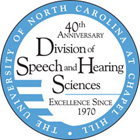Alternative and Augmentative Communication Devices
Center for Literacy and Disability Studies
Dr. Erickson demonstrates an eye gaze alternative communication device, also known as an “alternative pencil”
To illustrate the difference between training and teaching, Karen Erickson says it is one thing for children to learn the letters of the alphabet; it is another to learn what the letters are for and how to use them. ”I believe that nearly everybody is capable of learning,” she says. ”Having disabilities doesn’t mean children can’t learn; it just means we have to figure out how to help them learn.” She says teaching them takes more time and might require creative uses of technology, ”but the actual instruction we provide and the inside-the-head activities we’re trying to promote are the same as for children who don’t have any disabilities.”
As Director of the Center for Literacy and Disability Studies (CLDS), Dr. Erickson uses many tools for helping children learn to read and write and increase their communicative competence, including augmentative and alternative communication devices (AACs), and specially designed literacy materials.
”Our mission has always been to support communication today while we’re building literacy skills that allow you to communicate whatever you want tomorrow.”
-Karen Erickson, PhD, David E. & Dolores J. Yoder Distinguished Professor, Division of Speech and Hearing Sciences, and Director, Center for Literacy & Disability Studies
Dr. Erickson discusses the development of literacy materials
Dr. Erickson’s expertise in the area of AAC devices prompted Richard Ellenson, the father of a nonspeaking son with cerebral palsy to consult with her and other experts about the best way to develop a phrase-based, effective communication device. Dr. Erickson encouraged the company, Blink Twice (now DynaVox Mayer-Johnson), to use efficient ways to combine words and to have access to letters and spelling so that the user can say whatever he wants, not just what is available on the device. Dr. Erickson conducted feasibility studies and tested the device with children with and without disabilities. The ergonomics, symbols, realistic voices, camera, and alphabet windows were all features that made the resulting TANGO device a successful product.
To see a video of someone using TANGO in the community, visit: https://www.youtube.com/watch?v=Ce2J_uFFNtk (opens in new window).
Examples of other AAC devices include a color-coded eye gaze board where students select letters through looking at specific cards. Flipboards with letters are also used to allow the student to select letters with a pointer or light switch. One of the most interesting items is a tactualized book called Down in the Dumps, which includes Braille as well as rule-based tactual objects to develop concepts. The silver tip holding the eraser on a pencil represents a can; sandpaper represents roads. These books were developed to support children in the deaf-blind population.
Josh’s Assessment
Disc 1 Scene 2 – Wheels on the Bus
New Voices, Footpath Pictures
Copyright 2007
In the area of literacy, the CLDS has been involved in many partnerships to develop literacy materials for children with multiple disabilities. Erickson says, ”If you’re going to communicate using a symbol-based system, you’re always going to be dependent on other people to predict what you want to say. So until we teach you how to spell, you’re never going to be able to say everything you want to say.” Erickson has developed systematic phonics instructional programs to teach nonspeaking children how to decode and spell words, while also teaching them to communicate using a particular kind of picture-based communication system. ”Our goal,” she says, ”is to help teachers and speech-language pathologists have the tools that are required to support their children in learning language, literacy, and communication.”
For more information, visit the CLDS website: http://www.med.unc.edu/ahs/clds


 Communication Development and Disorders
Communication Development and Disorders





